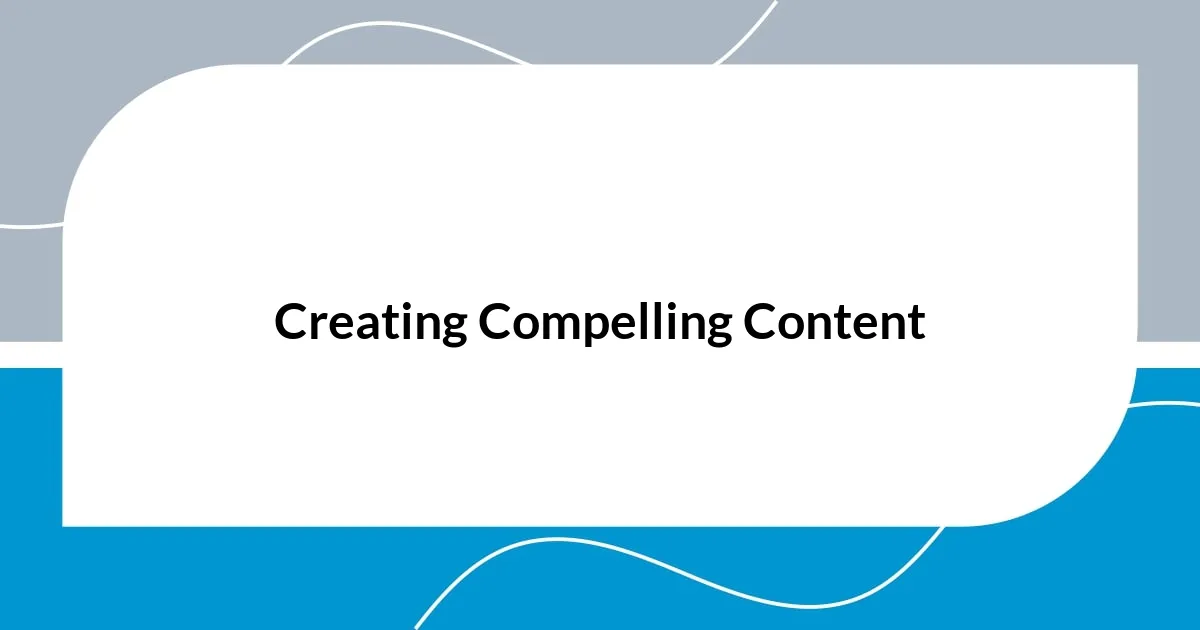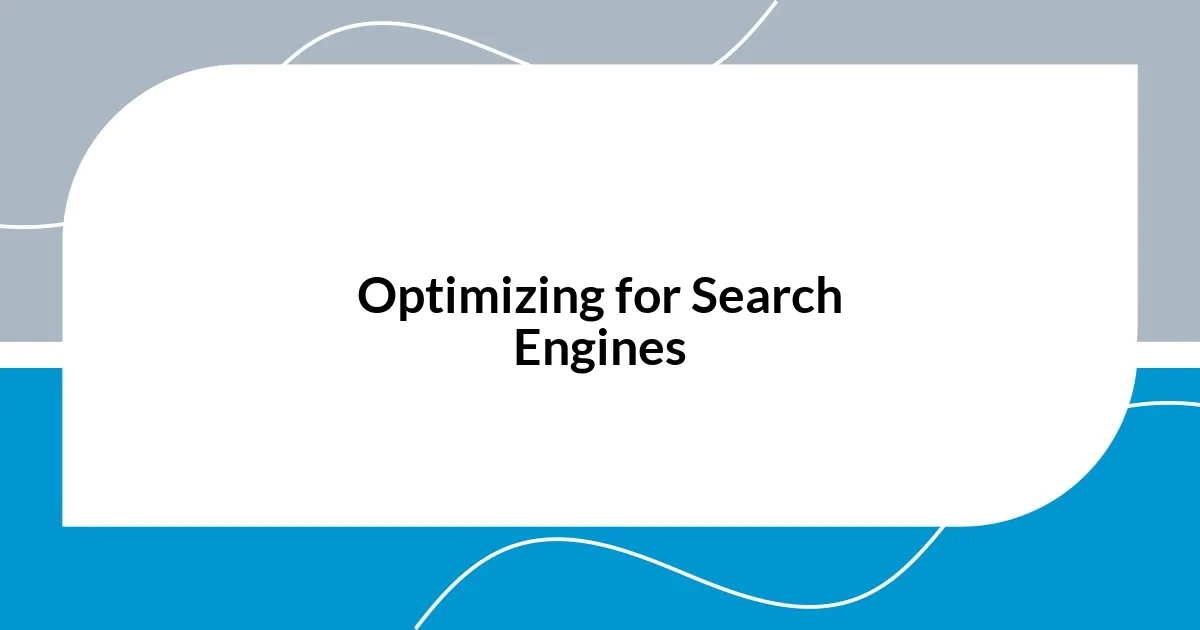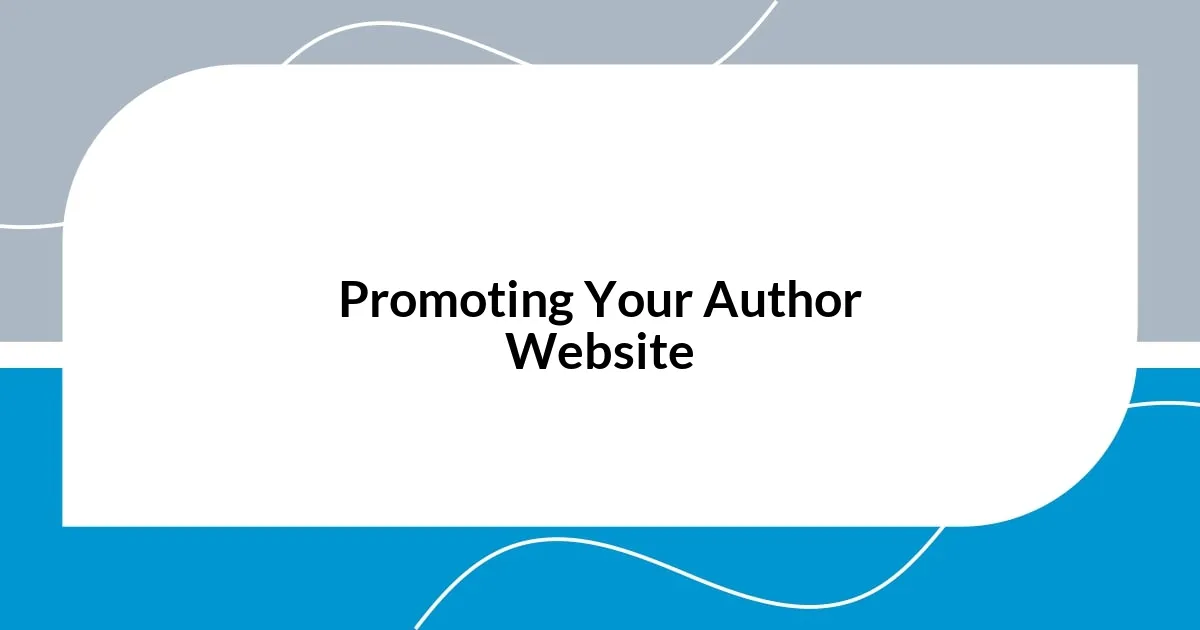Key takeaways:
- The author emphasizes the importance of choosing a user-friendly website platform that allows for future scalability and growth.
- Creating compelling content with personal stories and varied formats helps build a relatable connection with readers.
- Effective SEO practices and regular site maintenance improve visibility and enhance user experience.
- Promoting the website through social media, collaborations, and an email list fosters community engagement and support.

Choosing the Right Platform
Choosing the right platform for your author website can feel overwhelming, but I remember the moment it clicked for me. I initially spent hours comparing options, but I realized that what I needed was a platform that not only showcased my writing but also fit my technical comfort level. Does that resonate with anyone out there?
For me, ease of use was paramount. I had tried a few platforms that seemed promising but ended up being too complicated—think lots of confusing technical jargon! It wasn’t until I settled on a user-friendly option that I found joy in the design process. Honestly, isn’t it more rewarding to focus on your content rather than wrestling with software?
Another important consideration was scalability. I wanted a platform that could grow with me as my writing career evolved. This meant ensuring it could handle additional features later on, like e-commerce capabilities for selling books. Have you thought about your long-term goals? Trust me, having that foresight saved me a lot of headaches down the road!

Designing a User-Friendly Layout
When I dove into designing my author website, I quickly learned that a clean, intuitive layout is essential. I wanted visitors to find their way around effortlessly, without feeling lost amidst my content. There’s something almost liberating about having a clear structure; it allows the reader to engage easily with what matters most—the words I’ve crafted.
To achieve this, I focused on several key elements:
– Simplified Navigation: I organized my pages in a logical flow—home, about, blog, and contact—so users could explore without second-guessing.
– Readability: I chose a font and color scheme that ensured my text was easy to read. Very early on, I discovered that the ideal contrast can make a world of difference.
– Whitespace: I reserved ample space for breathing room around text and images, which made the content feel less cluttered and more inviting.
– Consistent Visual Hierarchy: By keeping headings, subheadings, and body text distinct, I guided the reader’s attention to important information naturally, almost like having a conversation with them.
Creating these elements helped me shape a warm yet professional tone that resonates with my audience—a quality I genuinely value.

Creating Compelling Content
Creating compelling content for my author website was both an exciting challenge and a deeply personal journey. I knew that every word had to reflect not just my writing style, but also my authentic voice. At first, I felt overwhelmed, but I soon realized that incorporating personal stories would make my content relatable and engaging. Have you noticed how a good story can draw you in? My favorite part was sharing snippets about my writing process; this glimpse into my world helped readers connect with me on a more personal level.
I also prioritized variety in my content. Blogs, excerpts, and even behind-the-scenes anecdotes kept things fresh. Once, I wrote a post about a particularly difficult day when inspiration seemed out of reach—this not only humanized my experience but also resonated with fellow writers facing similar struggles. Including such moments of vulnerability allows readers to see that they’re not alone. It’s exhilarating to share those raw, real emotions; it draws readers into my journey and builds that all-important community.
Lastly, I made it a point to update my content regularly. Fresh insights and new ideas can spark renewed interest. I found that even if it was just a brief update on my current projects, it reassured my audience that I was actively engaged in my craft. Readers appreciate knowing that behind every piece of content, there’s a passionate author who’s constantly evolving. Isn’t it fulfilling to share that journey together?
| Content Type | Description |
|---|---|
| Blog Posts | In-depth explorations of writing topics that resonate with my audience. |
| Excerpts | Teasers from my works that entice potential readers. |
| Behind-the-Scenes Stories | Personal anecdotes that provide insight into my writing process. |
| Updates | Regularly shared information about new projects, events, or milestones. |

Incorporating Author Branding Elements
Incorporating author branding elements into my website felt like weaving my story across different threads. I knew right away that my color scheme had to evoke the emotions I want my readers to feel—warm, inviting, and a touch whimsical. For example, I remember agonizing over the perfect shade of teal that has always inspired me; this choice ultimately became a reflection of my love for fantasy and adventure.
I also made a conscious decision to use consistent imagery that aligns with the themes of my writing. Every time I posted a photo or an illustration, I considered how it represented my brand. Once, I used a moody forest scene to accompany a piece about my latest novel; that visual not only captured the essence of my story but also created a cohesive atmosphere across my platform. Have you ever felt pulled into a world just by looking at a single image? I aimed to replicate that feeling for my visitors.
Lastly, I integrated my personal logo which combines both my initials and a quill pen. To me, it signifies my journey as an author—a reminder that every word is crafted with care. I can still recall the excitement I felt when I first saw it on my website, knowing that visitors would now identify my brand with that simple yet meaningful design. How powerful can a logo be in representing who we are? For me, it’s a foundational piece that encapsulates my writing journey, inviting readers to become part of this adventure.

Optimizing for Search Engines
Though optimizing for search engines might sound technical, I found it to be a vital part of my journey as an author. When I first dived into SEO (Search Engine Optimization), I was intimidated. My biggest breakthrough came when I realized that it was about more than just keywords; it was about improving how readers find and connect with my work. I remember spending a weekend researching different strategies, and it clicked: incorporating relevant keywords naturally into my blog posts not only boosted my site’s visibility but also enriched the content itself.
To personalize my SEO strategy, I focused on creating content that answered specific questions my audience might ask. For instance, I found myself writing a post titled “How to Overcome Writer’s Block,” which stemmed from my own struggles at the keyboard. By using tools like Google Keyword Planner, I pinpointed the exact phrases readers were searching for. Trust me, seeing that post gain traction brought me immense joy. It’s fascinating how using the language that resonates with your audience can create a bridge between us, inviting them to delve deeper into my world.
Additionally, I learned the importance of optimizing my site’s loading speed and mobile-friendliness. When I first launched my site, it felt sluggish, and that was an eye-opener. I took the time to streamline images and clean up unnecessary plugins. The difference was almost immediate; I could feel the flow of visitors increasing. Have you ever waited too long for a page to load and just decided to leave? I know I have. So, enhancing these technical aspects not only improved my SEO but made the experience more enjoyable for my readers—ultimately, a win-win!

Promoting Your Author Website
Promoting my author website has been like casting a net into a vast ocean of potential readers. One of my first moves was to leverage social media platforms—it’s amazing how these channels can create a vibrant community around my writing. I still remember the thrill of live-tweeting a reading event; the immediate engagement and feedback felt like a breath of fresh air, reminding me that there are real people out there who resonate with my stories.
As I explored different promotional strategies, I discovered the power of collaboration. Partnering with other writers for online events or blog features opened so many doors. I recall hosting a virtual book club with an author friend, sharing our insights while naturally weaving in links to our websites. It felt rewarding to not only promote my work but to create valuable connections and spotlight fellow authors. Really, isn’t it inspiring to lift each other up in this journey?
Another effective tactic was building an email list. I initially hesitated, thinking it might be too much work, but I couldn’t be more grateful for that decision. I remember my first newsletter—crafting it felt like sending a letter to friends. Sharing updates about my writing, exclusive content, and even behind-the-scenes glimpses fostered a personal connection with my readers. Aren’t those intimate moments what truly keep people coming back? It’s profound to think that through targeted promotions, I’ve cultivated a community that actively supports my journey.

Maintaining Your Website Regularly
Maintaining my author website has been an eye-opening experience; it’s not just a “set it and forget it” situation. After launching, I quickly learned that regular updates are crucial. I remember the panic I felt when a reader pointed out an outdated bio on my site—it was a small detail, but it made me realize how important it is to keep everything fresh and reflective of my current work. I now set aside time each month to review content, ensuring that it aligns with my evolving journey as an author.
Another key aspect of maintenance is checking for broken links. The first time I clicked on a link to one of my favorite references and it led to a dead end, I was frustrated. It dawned on me that my readers might feel the same way when navigating my site. I’ve since made it a routine to test all links and replace or remove any that don’t work. Keeping everything in working order makes the experience smoother for my visitors—and who doesn’t appreciate that?
Finally, I think engaging with my audience through regular blog updates or newsletter posts breathes life into my website. With every blog entry, I invite readers into my thoughts and experiences. Reflecting on my writing journey often reminds me of the days I struggled with self-doubt; sharing those moments now helps others realize they’re not alone. Isn’t it remarkable how our stories can connect us? Scheduled maintenance for my site becomes less of a chore and more of an opportunity to foster that connection.